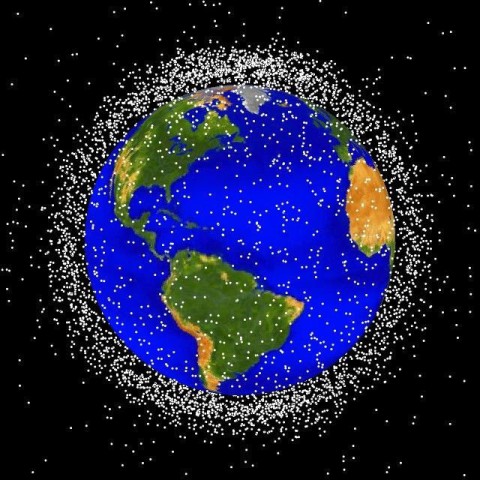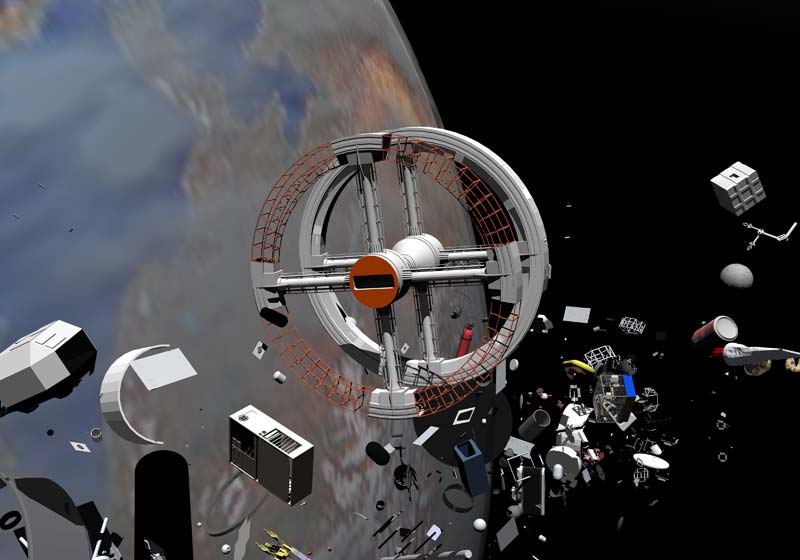Addressing the growing threat of space debris
According to the ESA's statistics, there are over 8,100 metric tonnes of man-made objects in space, ranging from just a few mm in size up to many meters.

The space-age commenced with the launch of the Soviet Union's Sputnik 1 satellite on October 4, 1957, and now 60 years on, there is more debris in the orbit than operational satellites, according to the European Space Agency's (ESA) Annual Space Environment Report.
For those not familiar with the term, space debris or space junk is defined as all of the non-functional or unresponsive artificial and natural (meteoroid) objects orbiting the Earth. It includes derelict spacecraft, dead batteries, payload carriers, upper stages of launch vehicles, debris generated after accidental satellite explosions or collisions or intentional destruction by conducting anti-satellite tests.
According to ESA's statistics, there are over 8,100 metric tonnes of man-made objects in space, ranging from just a few millimeters to many meters.
The number of debris objects to be in orbit (estimated by statistical models):
- 5,400 objects > 1m
- 34,000 objects > 10cm
- 900,000 objects > 1cm
- 130,000,000 objects > 1mm
The growing competition among countries to build up their space capabilities, especially the development of anti-satellite technology is significantly contributing to space debris. In 2007, China carried out the anti-satellite (ASAT) test by destroying 'Fengyun-1C', an old weather satellite with a surface-launched medium-range missile, adding more than 3,000 pieces to the US Space Surveillance Network catalog that routinely tracks debris greater than 10 centimeters. China's ASAT test alone increased the trackable space object population by 25 percent.
The most recent example is India's anti-satellite test. On March 27, 2019, the country destroyed its own low-orbit satellite with a ground-to-space missile, making it the fourth country in the world after the US, Russia, and China to have ASAT capabilities. Worryingly, the test, according to NASA, created about 400 pieces of orbital debris, potentially endangering space vehicles and the International Space Station (ISS).
Why space debris is a serious threat?
Human-made space debris enters Low Earth orbit (LEO) with most of them reaching speeds of 18,000 miles per hour, almost seven times faster than a bullet. It poses a serious threat to space vehicles, particularly to manned space flights and operational satellites that the world relies on for communication services, be it internet, global positioning system (GPS) navigation, weather forecasting, disaster management, national security, and other critical services.
The world needs geospatial information for developmental planning, policy formulation, and decision‐making in sectors ranging from urban mobility to education, telecommunication services, responding to natural hazards, agriculture, urban planning, water management, providing humanitarian aid and more. Satellites are the source of geospatial Information that provides the digital version of the physical world where all the social, economic and environmental activities take place.
 Image Credit: Wikimedia Commons
Image Credit: Wikimedia Commons
Collisions with debris larger than 1 cm can disable an active spacecraft or operational satellite and may cause the explosion of a decommissioned spacecraft or rocket body. According to ESA, objects ranging from 1 to 10 cm in size could cripple or kill any craft they hit. Even a single 10-cm debris collision event could wipe out a multi-million-Euro spacecraft or hit the ISS.
On the other hand, large space-debris objects such as spacecraft, rocket bodies or other fragments re-entering the atmosphere in an uncontrolled way can reach the ground and create a risk to the population on the ground. However, the individual risk posed by space debris re-entering the earth's atmosphere is little as compared to collective risks in the form of disrupted services.
Solutions
Just like pollution, the issue of space debris is of great concern. To clean the space environment for future missions and to safeguard the existing operational satellites, it's high time to address this growing global risk with more co-ordinated efforts and international cooperation.
Leading space agencies including the National Aeronautics and Space Administration (NASA), ESA, international institutions and a number of private companies are already working on the solutions to track and remove the debris already up there.
Late last year, NASA tested the NanoRacks-Remove Debris satellite. The ISS crew deployed the satellite into space to map the location and speed of orbital debris using a 3D camera. The next step was to deploy a net that captures simulated debris of up to 1 m in size. The NanoRacks-Remove Debris successfully deployed a net to capture a planned 'debris' target in orbit.
ClearSpace
The European Space Agency recently announced that it has commissioned ClearSpace-1, the world’s first space debris removal mission. The mission scheduled for launch in 2025 is being procured as a service contract with a consortium led by ClearSpace, a Swiss startup established by researchers at the Federal Institute of Technology Lausanne and will cost a staggering EUR 120 million.
Imagine how dangerous sailing the high seas would be if all the ships ever lost in history were still drifting on top of the water. That is the current situation in orbit, and it cannot be allowed to continue. ESA’s Member States have given their strong support to this new mission, which also points the way forward to essential new commercial services in the future.
The ClearSpace-1 mission will target the conical upper part of Vega Secondary Payload Adapter (VESPA) that was left in an 800 km by 660 km altitude orbit after the second flight of ESA’s Vega launcher back in 2013.
The ClearSpace-1 ‘chaser’ will be launched into a lower 500-km orbit for critical tests and thereafter its orbit will be raised where it will capture VESPA using a quartet of robotic arms and then de-orbit itself and the target to burn up in the atmosphere.
Northrop Grumman
US aerospace and defense company Northrop Grumman has designed a first of its kind Mission Extension Vehicle (MEV) to dock with satellites running low on fuel. The company's ground-breaking 'MEV-1' spacecraft, launched back in October 2019, will connect with an Intelsat-901, an operational satellite in need of life support, early next year. The MEV-1 uses a reliable, low-risk docking system that attaches to existing features on the target satellite and provides life-extending services to it by taking over the orbit maintenance and attitude control functions.
Astroscale
Another company joining the race to capture and remove the orbital debris is Astroscale. The company is working on two types of solutions:
- End-of-Life Services by Astroscale (ELSA) - to mitigate potential future debris
- Active Debris Removal (ADR)- to capture and remove existing debris in the orbital environment
ELSA-d (demonstration), the company's first mission to demonstrate the core technologies necessary for space debris docking and removal will be launched in 2020. Demonstrations include target search, target inspection, target rendezvous, and both non-tumbling and tumbling docking.
The company is also developing missions to capture and remove environmentally critical debris, such as rocket upper stages and defunct satellites that are already in orbit.
(Disclaimer: The opinions expressed are the personal views of the author. The facts and opinions appearing in the article do not reflect the views of Devdiscourse and Devdiscourse does not claim any responsibility for the same.)
- FIRST PUBLISHED IN:
- Devdiscourse
ALSO READ
Science News Roundup: White House directs NASA to create time standard for the moon; Scientists investigate thousands of dead Antarctic penguins for bird flu and more
Here's how NASA's future telescope will determine ages of stars
Science News Roundup: Scientists investigate thousands of dead Antarctic penguins for bird flu; White House directs NASA to create time standard for the moon and more
Science News Roundup: Scientists investigate thousands of dead Antarctic penguins for bird flu; White House directs NASA to create time standard for the moon and more
NASA to launch three sounding rockets during solar eclipse










